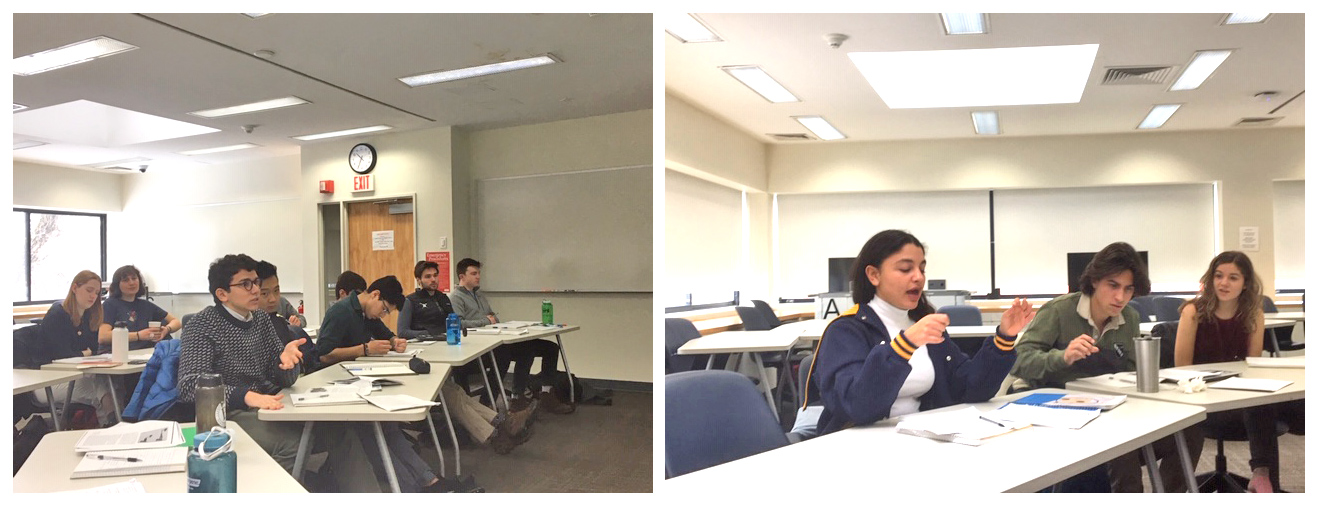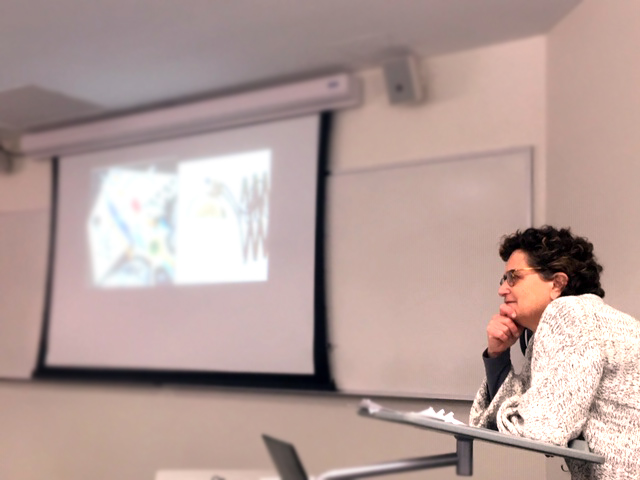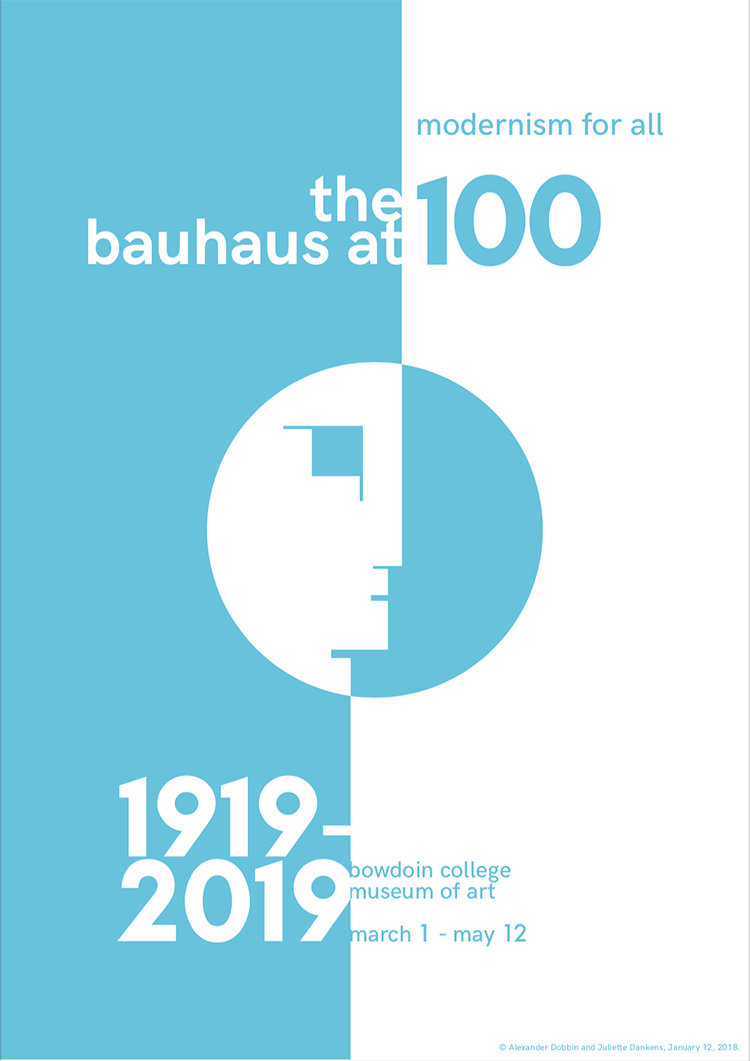Exploring a Legacy
By Tom PorterThese were some of the questions being tackled recently by students taking The Bauhaus and its Legacy: Designing the Modern World (ENVS 2470/ARTH 2470). The course is taught by Senior Lecturer in Environmental Studies Jill Pearlman, who specializes in the history of architecture and urbanism.
Pearlman devised the course to coincide with the one hundredth anniversary of the pioneering German modernist school of art and design, which operated from 1919 to 1933, when it was closed down by the Nazis. It’s part of a mosaic of offerings at Bowdoin College this year celebrating the Bauhaus, both inside and outside the classroom.

Combining fine arts with crafts and industrial design, the Bauhaus influenced everything from paintings and sculptures to furniture and, of course, buildings (the word “Bauhaus” means “construction house.”) “The Bauhaus was engaged in shaping the human environment at every level, from the teacup to the city,” Pearlman explained. “The Bauhaus gave modernity a distinct physical form and in doing so, it changed the world."

The Bauhaus has long been an area of research for Pearlman, who’s 2007 book, Inventing American Modernism (University of Virginia Press), examines the role Bauhaus emigres played in shaping architecture and urban design in the US after World War II. She’s exploring a similar theme for her next publication, she explained. “I’m currently writing a book about modernism in London’s built environment, and the Bauhauslers play a huge role here as well. So the Bauhaus has been with me for many years. Teaching a course on it is a natural for me.”
Pearlman’s students are clearly energized by the class. Walter Gadsby ’20 plans to become an architect. “In these first few weeks of class I've come to realize just how revolutionary the school was and have found it fascinating to learn about the specific methods that the school’s founder Walter Gropius, and other teachers like Johannes Itten and László Moholy-Nagy used to lead their students away from the traditional fine-arts academy approach to design and cultivate an entirely new set of criteria for evaluating art and architecture.” Every day, Gadbsy said, it became more evident to him how the Bauhaus has impacted the design practices of today.
Evelyn Beliveau ’19 is a visual arts major. “I’ve appreciated the opportunity in this course to discuss the role of art in the stuff of daily life and the intentional construction of spaces and experiences.” She said the class has also given her a greater appreciation of the movement’s political context.
“The Bauhaus’s reimagining of art and design could not have come about without the particular situation in interwar Germany; its instability allowed for a leap away from the academy system of the past.”
—Evelyn Beliveau ’19
A Campus-Wide and Student-Inspired Effort

Outside of Pearlman’s class, there are multiple opportunities for members of the Bowdoin community to learn about and celebrate the Bauhaus centenary. Visual arts students are incorporating Bauhaus techniques into some of their course work, some of which will be on display in the Edwards Center for Arts and Dance in late March. On March 1, the Bowdon College Museum of Art will unveil its latest exhibition Modernism for All: The Bauhaus at 100, which features works of art by Bauhaus masters and their students.
The exhibition, which runs through May 12, 2019, was the brainchild of two recent Bowdoin graduates, who, as seniors, floated the idea of a centennial Bauhaus show to museum staff in the fall of 2017. Alex Dobbin and Juliette Dankens were both introduced to the Bauhaus through Jill Pearlman’s Modern Architecture class, and both ended up doing independent study projects on the subject under Pearlman during their senior year.

“I became interested in how the Bauhaus really was a turning point in the history of architecture and art,” said Dankens. “I see it as the start of the modern era and how we think about and design art today.”
The overall goal of Bauhaus designers, said Dobbin, was to improve everyday life for everyone, something that is still highly relevant. “Part of our intention with the show,” he explained, “is to bridge the gap between the era of the Bauhaus and today and illustrate the impacts of these objects, which are nearly 100 years old, on our everyday lives today.”
Dankens and Dobbin both studied visual arts at Bowdoin—she was a major and he a minor—and they’re now both pursuing architecture-related careers: Dobbin is working as a designer for a New York-based architecture firm, while Dankens works in marketing for a firm in Boston and plans to pursue a master’s degree in architecture.
In cooperation with curator Joachim Homann, they began assembling the fifty-two items that will be on display. Besides the purely artistic objects, such as paintings, photographs, and sculpture, there are functional, design-oriented artifacts, such as door handles, items of furniture, coffee pots, a tea cup, and a chess set.
One of his favorite pairings in the exhibition, he said, is the eye-catching silver sculpture by Oskar Schlemmer depicting a grotesque figure, and the mass-produced glass coffee maker in the adjacent display case. There are clear parallels in the design, even though there was no direct relationship between the two objects, said Homann. “It’s funny how they seem to be talking to each other.”
In the months leading up to the exhibition, Homann was also assisted by Danny Banks ’19, an art history and German double major. Although some of the artifacts are owned by the museum, Homann said most of the items on display were borrowed, principally from the Sabarsky Collection in New York or from Gropius House—the former Massachusetts home of Walter Gropius, run by the heritage organization Historic New England.
“The programming around the show is truly collaborative,” said Homann, “involving colleagues from the Departments of German, Environmental Studies, Visual Arts, and Music.” The musical component is being supplied by Senior Lecturer in Music Frank Mauceri, who on April 9 will lead a student performance of music inspired by the Bauhaus.
To celebrate the opening of Modernism for All: The Bauhaus at 100, guest speaker Elizabeth Otto, an art historian from the University at Buffalo (SUNY), will deliver a public lecture, “Haunted Bauhaus,” Friday, March 1, at 3:00 p.m. in the Kresge Auditorium.